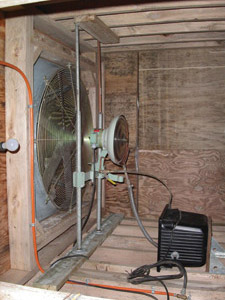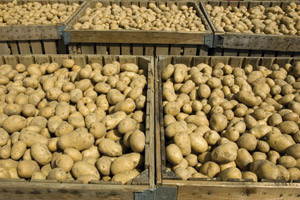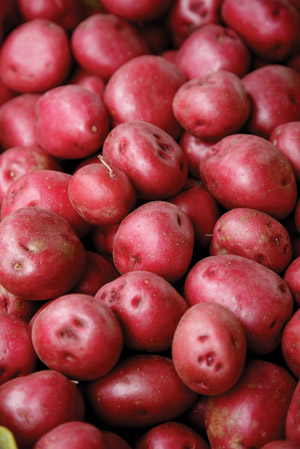
Features
Fruit
Production
Potato humidity: A key aspect of storage management
A key aspect of storage management
October 3, 2008 By Lukie Pieterse
Shrinkage and the consequent loss
of weight of potato tubers is one of the most significant challenges
that faces anyone in charge of a potato storage facility.
Shrinkage and the consequent loss of weight of potato tubers is one of the most significant challenges that faces anyone in charge of a potato storage facility.
Potato tubers contain about 80 per cent water, and potatoes in storage will loose a significant amount of this water by evaporation if the tubers are surrounded by dry air during the storage period. The drier the air of the storage facility, the greater the evaporation, and thus, the more the loss in weight. Effective storage of potatoes always requires an equal balance between the water in the potato and the humidity of the surrounding air.
 An example of a centrifugal humidifier installed in a potato storage. This system works by throwing water from a spinning disk across a set of knives to produce a mist of small droplets. This kind of system requires regular cleaning of disks, knives and pump screens to remove mineral deposits but is fairly low maintenance, portable, and has low cost and flow rate variables. |
Evaporation is responsible for the majority of weight losses when potatoes are stored, and it is therefore important that this is kept to the lowest possible level by the storage manager. By continuously surrounding the potatoes with air containing a high relative humidity, evaporation can be significantly reduced, and weight losses minimized. Water losses cause the potato to be dehydrated, resulting in weak potatoes with poor quality, inferior texture, discolouration when processed, and often loss of taste when offered to the table market.
According to potato specialists at the University of Idaho’s Storage Research Unit in Kimberly, the single most important part of the storage season begins with the wound healing or curing period.
During this period, they say, potatoes need to be stored for approximately two to three weeks at 50 to 55 F and 95 per cent relative humidity. During this time, the potato becomes more resistant to storage diseases and shrinkage. Wound healing, repair of cuts and bruises, the formation of a protective layer between the tuber surface and the interior tissue, are all required for potato lots, whether they are intended for short- or long-term storage.
Humidification can considerably improve the quality of potatoes during storage. Since dehydration leads to decreased weights, storage losses can be reduced by the prevention of evaporation. If the air in a potato storage facility is not humid enough, the greatest dehydration occurs on the bottom layers of the potato pile, because these potatoes are the first to come into contact with the dry air. Therefore, these potatoes lose the most water and become the most dehydrated. This implies that the potatoes subjected to the most weight are also subjected to the greatest potential for bruising damage. Humidification enables potatoes to be stored in much higher piles without the risk of damage caused by bruising.
Humidity in the potato storage facility is closely connected to the basic principles of relative humidity. Potato storage specialist Doug Trivers, based in Ontario, explains that relative humidity (RH) can be defined as “the actual amount of water vapour in an air mass relative to the amount of water vapour that air can hold at that temperature.” As air heats up, the ability to hold moisture increases. If air is warmed without changing the amount of moisture in the air, the relative humidity will drop, Trivers notes. The larger the increase in temperature, the greater the driving force of water from the potato to the air.
“Consider air entering a potato pile at 45 F and 98 per cent RH,” Trivers says. “As the air passes over the potatoes, it removes heat from the potatoes and the temperature of the air increases. The air passing over the potatoes will also pick up moisture from the potatoes due to transpiration and respiration. For the example, let’s assume the amount of water vapour in the air does not change. If the air warms 2 F, the RH will drop to about 91 per cent. If the temperature rises by 5 F, the RH would drop to about 81 per cent. The lower the humidity of the air surrounding the potato, the greater the rate of moisture loss from the potato to the air.”
Trivers advises storage managers to reduce the temperature rise across the stored potato pile to about 2 F to minimize shrinkage. He is of the opinion that the temperature of air entering the pile should be no more than 2 F cooler than the temperature of the tubers.

Shrinkage and the consequent loss of weight of potato tubers is one of the most significant challenges that face anyone in charge of a potato storage facility.
|
“When cold fresh air is brought into the storage, the effect on humidity is dramatic,” he says. “If outside air at 30 F and 80 per cent humidity is warmed to 45 F, the RH drops to about 30 per cent. If this outside air is mixed with return air ( 47 F, 91 per cent RH from above) to provide 45 F air, the humidity will be about 90 per cent. To maintain a high humidity environment, a humidifier will be required.”
Trivers points out that a humidifier introduces liquid water into the air stream that can be evaporated to increase the amount of water vapour in the air.
“The amount of actual humidification depends on the time the water and air are in contact and the temperature of the water,” he says. “The longer the air and water are in contact, the greater the chance for heat from the air to evaporate water.”
One of the most important factors in how much humidification is provided is the temperature of the water in relation to the dew point of the air mass, according to Trivers.
“If the water temperature is lower than the dew point, no humidification will take place. As a matter of fact, water vapour from the air will condense to the water particles to dehumidify the air. In most storages, heat is released to the air as it passes across the fans. This heat is available to evaporate water.”
 Potato tubers contain about 80 per cent water. The drier the air of the storage facility, the greater the evaporation, and thus, the greater the loss in potato weight. Effective storage of potatoes always requires an equal balance between the water in the potato and the humidity of the surrounding air. |
In Trivers’ experience, humidifier water temperature must be greater than the dew point of the plenum air in a storage facility to achieve humidification.
According to Trivers, storage humidity is more dependent on the ventilation system management then on the type of humidifier.
“All types of humidifiers on the market today can be effective if properly managed and maintained,” he says. “The selection of a humidification system should be based on the system management and maintenance, not necessarily on the reported efficiency of the system.”
In a brief overview of humidiciation systems, Trivers decribes a centrifugal system as a system where water is thrown from a spinning disk across a set of knives to produce a mist of small droplets. This kind of system requires regular cleaning of disks, knives and pump screens to remove mineral deposits. It requires fairly low maintenance, is usually portable, low cost, and flow rate variable.
A high pressure water system involves a high pressure pump to deliver water at 500 to 600 psi to a system of fog nozzles, according to Trivers. This kind of system, he says, requires regular cleaning of nozzles and screens, belt tension adjustment, and pump oil level maintenance. This humidification system is relatively low cost and can be used for multiple bins, but storage managers should expect free water on the plenum floor. This can be managed with a floor drain.
A pneumatic system of humidification involves pressurized air from an air compressor and water under pressure mixed at a fog nozzle. The storage manager needs to clean nozzles and screens regularly, maintaining the compressor, replacing the water filters as well as the air line filters when needed. Although this kind of system provides smallest particle size of all misting systems, Trivers pointed out that proper management is required to prevent small particles from depositing “free water” on potatoes.
The last type of humidification system that Trivers mentions is an “evaporative cooling cell” system where air passes at low speed across a water soaked cellulose matrix. The cell is constructed with two sets of corrugations, one set allows water to trickle down from the top to wet the pad. A second set of horizontal corugations are provided to accommodate airflow.
The air passing the wetted material picks up moisture along the way. This kind of system virtually eliminates free water from the plenum, he says, and allows for evaporative cooling in dry climates. It is important though that the storage manager prevents the pad from repeated wet /dry cycling to extend the life of the system. The system has limited evaporative cooling benefit in humid regions, is relatively costly, and requires a larger fan room/plenum. In arid regions, additional humidification may be required downstream of the cell.
Further information on potato storage humidification can be obtained from Doug Trivers at Dayson Agrivent: 905-770-6662, or daysonagrivent@sympatico.ca .
Print this page